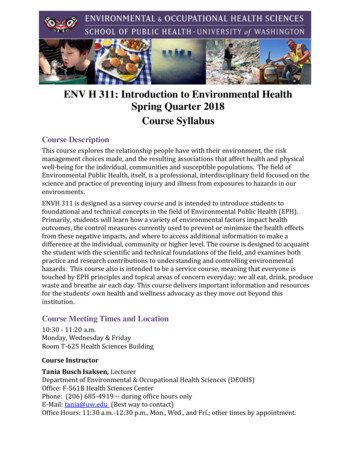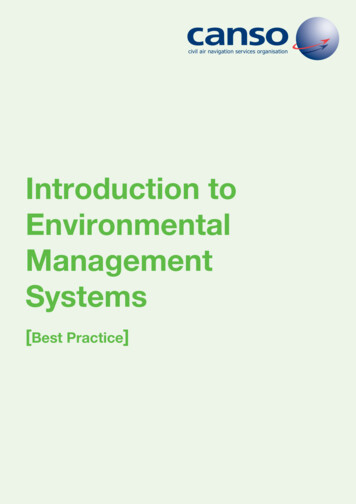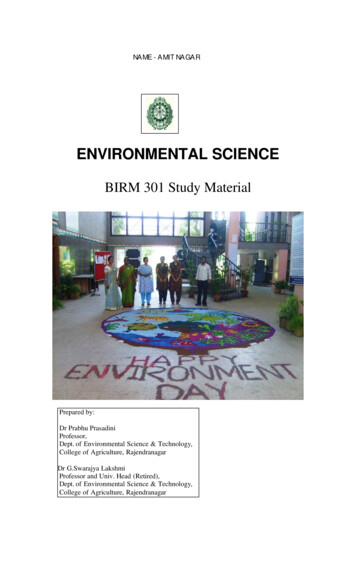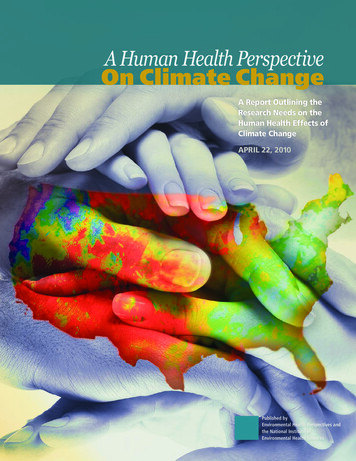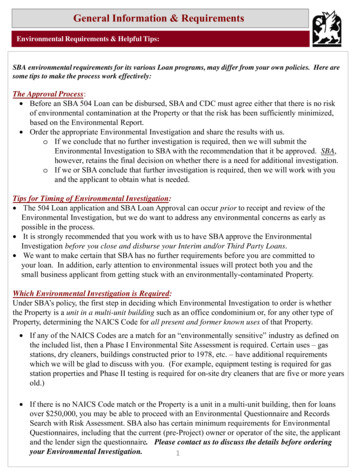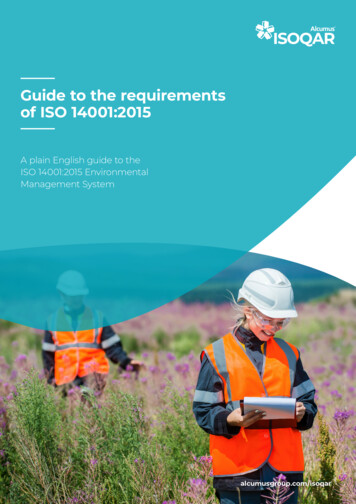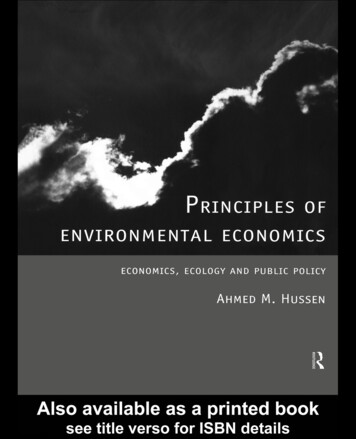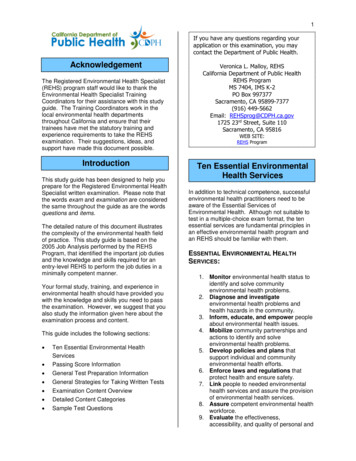
Transcription
1If you have any questions regarding yourapplication or this examination, you maycontact the Department of Public Health.AcknowledgementThe Registered Environmental Health Specialist(REHS) program staff would like to thank theEnvironmental Health Specialist TrainingCoordinators for their assistance with this studyguide. The Training Coordinators work in thelocal environmental health departmentsthroughout California and ensure that theirtrainees have met the statutory training andexperience requirements to take the REHSexamination. Their suggestions, ideas, andsupport have made this document possible.IntroductionThis study guide has been designed to help youprepare for the Registered Environmental HealthSpecialist written examination. Please note thatthe words exam and examination are consideredthe same throughout the guide as are the wordsquestions and items.The detailed nature of this document illustratesthe complexity of the environmental health fieldof practice. This study guide is based on the2005 Job Analysis performed by the REHSProgram, that identified the important job dutiesand the knowledge and skills required for anentry-level REHS to perform the job duties in aminimally competent manner.Your formal study, training, and experience inenvironmental health should have provided youwith the knowledge and skills you need to passthe examination. However, we suggest that youalso study the information given here about theexamination process and content.This guide includes the following sections: Ten Essential Environmental HealthServicesPassing Score Information General Test Preparation Information General Strategies for Taking Written Tests Examination Content Overview Detailed Content Categories Sample Test QuestionsVeronica L. Malloy, REHSCalifornia Department of Public HealthREHS ProgramMS 7404, IMS K-2PO Box 997377Sacramento, CA 95899-7377(916) 449-5662Email: REHSprog@CDPH.ca.gov1725 23rd Street, Suite 110Sacramento, CA 95816WEB SITE:REHS ProgramTen Essential EnvironmentalHealth ServicesIn addition to technical competence, successfulenvironmental health practitioners need to beaware of the Essential Services ofEnvironmental Health. Although not suitable totest in a multiple-choice exam format, the tenessential services are fundamental principles inan effective environmental health program andan REHS should be familiar with them.ESSENTIAL ENVIRONMENTAL HEALTHSERVICES:1. Monitor environmental health status toidentify and solve communityenvironmental health problems.2. Diagnose and investigateenvironmental health problems andhealth hazards in the community.3. Inform, educate, and empower peopleabout environmental health issues.4. Mobilize community partnerships andactions to identify and solveenvironmental health problems.5. Develop policies and plans thatsupport individual and communityenvironmental health efforts.6. Enforce laws and regulations thatprotect health and ensure safety.7. Link people to needed environmentalhealth services and assure the provisionof environmental health services.8. Assure competent environmental healthworkforce.9. Evaluate the effectiveness,accessibility, and quality of personal and
2population based environmental healthservices.10. Research for new insights andinnovative solutions to environmentalhealth problems.terms for each content area. Create yourown glossary of terms and look up any newwords in a reference book. The test will contain items at various levelsof cognitive ability. Consequently, it isimportant to be able to understand, apply,and analyze the material as you would onthe job. Although all questions will be in amultiple-choice format, the items will bepresented in a number of forms. Forexample, a written scenario may be followedby a series of three or four questions. Some test takers are anxious about takingtests and need to simulate the test takingsituation. If this is true for you, you maywant to give yourself actual practice in aquiet, distraction-free environment.Passing Score InformationA criterion-referenced approach (e.g.,Modified-Angoff method) is used by licensureand certification exams for setting the passpoint. The Modified-Angoff method is usedto set the pass point for the REHS exams; itinvolves setting the pass point on the basisof minimum standards for competentpractice (i.e., job requirements) rather thanrelative candidate performance (e.g., gradingon the curve.). Subject matter experts in thefield are consulted throughout the process toensure a fair and accurate pass point.Standards are consistently applied to allforms of the exam to ensure a fair pass pointfor all candidate groups. An advantage ofthis approach is that the pass point may belowered for a hard exam and increased foran easy exam.General Test PreparationInformationFollowing is information to help you study for thewritten examination for the State of CaliforniaEnvironmental Health Specialist Registration.Do some work every day in preparation for theexamination. Budget your time; set aside adefinite study period for each day. Beginconcentrating as soon as you sit down to study. Study by yourself and with others toencourage an exchange of ideas. Yourstudy should focus on content areas listed inthis study guide. It is not advisable forcandidates to memorize large groups of testquestions for the REHS examination. Alarge computerized item bank has beencreated to generate different test forms on aregular basis.The focus of your study should be onknowledge and skills relevant to a newlyregistered Environmental Health Specialist.Develop your own illustrations and examplesto check on your understanding of a topic.Make sure you fully understand the basicGeneral Strategies for TakingWritten TestsThe basic format for this test is the multiplechoice format with four choices. Here are somegeneral hints for taking this type of test: Most importantly, the test is designed tohave only one answer that is best fromamong the four choices given. Your attitude about the test process canmake a difference. Approach the testconfidently. Arrive in plenty of time for thetest so you do not feel rushed. Be certain that you understand how tocorrectly use the computer scannableanswer sheet. Make sure you are careful tomake clean erasures on your answer sheetand to only mark one correct answer per testitem. Instructions, which will be read to you by aproctor, are very important, so be sure tolisten carefully. These may include helpfulclues. Ask questions if there is somethingthat you do not understand about theinstructions, but be aware that your proctorcannot answer questions about test contentissues. Read all directions carefully, twice ifnecessary. Your score on this test will be based only onthe number of correct choices you make (the
3number of times you select the best choicefrom the four given). All test items areequally weighted even though there aredifferent weights for specific program areas.You may guess on questions that you arenot sure of as you go through the test. Markthem in your booklet for furtherconsideration if you have time after youfinish the entire test. Remember, this testdoes not penalize you for incorrect answersor guessing. Read each question carefully, making surethat you understand it before you answer.Reread it, if necessary, but do not wastetime on questions that seem too unfamiliaror difficult. Interpret words according to theirgenerally accepted meanings. Rephrase orunderline key words in difficult questions.No question is intended to be a “trick” or“catch” question.Answer the easy questions first; postponeanswering the more difficult questions untillater, making an initial guess in case you donot have enough time to go back to it.Check your answers if you do have time;however, remember that often your firstresponse is correct. Watch your time carefully during the test. If you find a question that you believe maybe incorrect, you can comment on thecalculation sheet provided. Include why youbelieve the question may be incorrect. Thismust be done during the allotted time foreach examination book. Subject matterexperts and testing specialists will carefullyreview all comments. Try to focus on doingwell on many items on the test rather thangetting bogged down on “making your case”on just one item that counts as one point.We use extensive quality control measuresto ensure a flawless test, including panelreviews by qualified subject matter expertsin your field and state-of-the-artcomputerized scoring and item analysistechniques.Examination Content OverviewThe examination covers a wide range ofenvironmental health topics. Below, theenvironmental health knowledge areas are listedaccording to their relative emphasis currentlyapplied in California. The next section providesinformation on the specific knowledge and skillscovered on the test. The interrelated nature ofthe environmental health knowledge and skillsmeans that many questions will relate to morethan one topic. The examination contains 260questions. For administration purposes, the 260questions are split into two booklets—eachcomprised of 130 questions. Highest Emphasis on the Exam (not inany order of importance): General Math and Science Inspections and Investigations Food and Consumer Protection Drinking Water Recreational Waters and Public Pools Medium Emphasis on the Exam (not inany order of importance): Hazardous Materials and HazardousWaste Management Solid Waste, Medical WasteManagement Bloodborne Pathogens Wastewater Management Disaster Management Vectorborne and Zoonotic DiseaseControl Lowest Emphasis on the Exam: Air Quality and Pollution Control Housing and Institutions Land Use
4Detailed Content CategoriesA detailed description of each environmentalhealth program area follows. The specificcontent areas should be interpreted broadly.When examples are provided in the followingstatements, they are not necessarily inclusive ofall of the things that may be tested. Additionally,each form of the REHS examination samplesthe knowledge and skills listed below; all of therelevant knowledge and skills are not assessedon a particular exam.GENERAL ENVIRONMENTALHEALTHThis section is comprised of 55 questionscovering (1) general math and scienceknowledge and skills and (2) knowledge andskills about the inspections and investigationprocess. General Math and Science Random sampling Basic arithmetic Addition Subtraction Multiplication Division Calculate percent Epidemiology General terms and principles ofepidemiologyo Case studieso Etiologyo Index caseo Fomiteso Correlation vs. association Types of outbreakKnowledge of:o Endemic Algebrao Sporadic Solve simple algebraic andquadratic equations Convert measurement units Milligrams per liter to ppm Geometry and trigonometry.o Epidemico Pandemic Disease attack rateo Incidenceo Prevalence Areaso Mortality rate Volumeso Morbidity rate Interpret graphs, charts, etc Statistical terms and principles Limiting or exacerbating factorso Age Meano Occupation Mediano Health Modeo Environmental factors Rangeo Behavioral risk factors Variabilityo Virulence Probabilityo Immunity/vaccination Normal distribution, bell shapedcurve Skewed distribution Correlation Regressive vs. progressivestudies Highly susceptiblepopulation Acquired immunity Modes of transmission/ exposureo Fecal/oralo Droplet contamination
5o Exudates of mucousmembraneso Hydrocarbons Unsaturatedo Bloodborne Polyunsaturatedo Vectorborne Saturatedo Dermal exposureo Contaminated food or watero Direct contacto Contaminated fomiteso Secondary infection Patterns of diseaseo Incubation period Biochemistryo Semi permeable membranes Biology Cell biologyo Major organelleso Eucaryoteso Procaryoteso Duration of symptoms Vertebrates vs. Non-vertebrateso Carrier Physiologyo Asymptomatico Major systemso Convalescence Respiratoryo Period of communicability Circulatoryo Intermediate hosts/vectors Digestive General Chemistry Nomenclatureo Periodic tableo Atomic weighto Stoichiometry Parts of atomso Electronso Protonso Neutrons Valance Bonding Oxidation-reduction reactions Molecules vs. atoms vs. elements, pHo Acid, alkalineo Logarithmic scale Organic Chemistry Organic vs. inorganic structures Isomers Free radicals Carbon bondso Benzene rings Immune system Anatomy Major organs Bones Tissues Eyes, skin and nasal passages Ecology Diversity Habitat Niche Carrying capacity Taxonomy Kingdom Phylum Class Order Family Genus Species Genetics Mitosis – Meiosis
6 Recessive genes, Dominantgenes Phenotype, Genotype Evolution Natural selection Microbiology General awareness of microbialtypes of disease causingorganisms of human importance Bacteriao “Red tides”o Paralytic Shellfish Poisoning(PSP) Helminthes, Nematodes, andTrematodeso Anisakinaeo Ecinococcuso Taeniao Ascariso Schistosomao Escherichiao Trichinosiso Salmonellao Necatoro Shigella Viruso Enterobactero Hepatitis A and Bo Mycobacteriumo Acquired ImmunodeficiencySyndrome (AIDS)o Staphylococcuso Streptococcuso Clostridiumo Vibrioo Listeriao Bacilluso Yersiniao Campylobacter Rickettsiao Rickettsia Fungio Noroviruso Encephalitiso Western equine viruso St Louis viruso West Nile viruso Hantaviruso Influenzao Lyssavirus Laboratory tests to identifypathogens Rodso Aspergilla Coccio Stachybotrys Spirocheteso Tinea Gram staino Coccidioides Acid fast stain Protozoao Plasmodiumo Amoebao Giardiao Toxoplasmao Cryptosopridiumo Cyclosporao Entamoeba Algaeo Blue-green algae Spore formers Cyst formers Lactose fermenters Microbial growth and multiplication Bacterial reproductiono Generation timeo Phases of growth Lag phase Log phase
7 Stationary phase Die off Viral reproduction Dependent on host cello Poison Exposureo Acute vs. chronico Inhalationo RNA/DNAo Ingestiono Protein coato Injectiono Mutationo Dermalo Resistanceo Phage Microbial terms Obligate aerobes Obligate anaerobes Facultative anaerobes Psychrophiles Effect of Doseo Lethal Dose (LD 50)o Dose / responseo Time Weighted Average (TWA) Inspections and InvestigationsKnowledge of: Basic legal terminology Mesophiles Consent Thermophiles Deposition Acidophiles Subpoena Neutrophiles Injunction Alkalophiles Impound Halophiles Embargo Halotolerant Seizure Osmophiles Permits Xerophiles Condemnation Endotoxin Voluntary Condemnationand Destruction Exotoxin Physics Structure of Matter Legal methods used to obtaininformation during investigationsand inspections Acceleration, Velocity and Force Observation Newton’s Laws of Physics Interviews Relativity Written communications Waves and Particleso Review operator’s files Energyo Historic office/file review Atomic Structureso Public records act Toxicology Termso Carcinogenic Evidence collectiono Inspection warrant Methods of lawful inspectionso Tetrogenico Right of Entryo Teratogenico Plain sighto Mutagenic
8 Jurisdiction, authority and structureof environmental health agencies. State law vs. delegated authorityfrom federal government Local vs. state jurisdiction Authority of the Health Officer too Enforce laws, regulations,codes and ordinanceso Inspect facilities / private andpublic propertyo Issue and condition permits tooperateo Impound, embargo, seize,condemn property Legal Process Administrative authority Labeling Documentation Legal authority to collect samples Personal Protective Equipment(PPE) and Safety Calibrate, use, maintain, andinterpret the results of fieldinspection equipment. For eachpiece of equipment named belowknow what it measures, how tooperate and maintain it and thelimits of the equipment.o Thermometerso Pool test kitso Combustible gas meterso Fat analyzerso Notice of Violationo Hydrometero Notice to Complyo pH test strips, or metero Notice and Ordero Sanitizer test strips (chlorine,quaternary ammonium, andiodine)o Intent to Close/Notice ofClosureo Cease and Desist Ordero Maximum registeringthermometer or thermolabelso Administrative or OfficeHearingo Digital camerao Administrative penaltieso Due process Civil vs. Criminal Lawo Infraction vs. misdemeanorvs. felony How a bill becomes a law Understand codes with multiplesections, paragraphs,subparagraphs, articles,exemptions, etc. General environmental samplingand testing concepts Chain of Custody Sample Integrity/Protocolso Photo ionization detector Cultural practices and norms Awareness of cultural differences Possible offensive behavior Respect for others Administration Principles Developing vision, goals andobjectives Finance and budgeting Personnel supervision Program monitoring andevaluation Basic interviewing techniques andprincipleso Transportation Introductiono Temperatures Observationso Timeliness Representative Sampling Identification of applicableenvironmental health laws Aseptic Technique Open ended questions
9 Demonstrationso Hydration/heat stress Explanationso Poisonous plants Documentationo Animals Location and timing of interview Exit interview protocol Conflict resolution techniques De-escalation Occupational Safety and HealthAdministration (OSHA)requirements related toEnvironmental Health occupationso Confined spaces Developing listening skills Equipment Empathy Partner Paraphrase and repeating Air supply Body languageo Trench shoring Approach – first impressiono Material Safety Data Sheet(MSDS) Know when to leave Ethical practices Conflict of interest Gratuities/gifts Professional code of ethicso Illness Injury PreventionProgram ( IIPP)o Office safety Ergonomics Risk assessment Public accountability/transparency Identify public health risks Consequences of unethicalpractices (e.g., REHS revocation) Respond appropriately to publichealth impacts Confidentiality Project/time management Slander/defamation/libel/rumors Favoritism/recommendations Illegal Discrimination Personal accountability Work ethics Personal protection equipment andprocedures Hard hat/other protectiveheadgear Ear plugs Air purifying respirators Gloves Goggles Safety shoes Environmental hazardso Sun protectiono Insect repellanto Prioritize workloadENVIRONMENTAL HEALTHPROGRAM AREASThis section of the exam is comprised of atotal of 205 questions specific toenvironmental health program areas.The knowledge and skills gained during thetime spent in an approved training programOR an environmental health internship willbe helpful in answering these multiplechoice questions. Food and Consumer ProtectionKnowledge of: Jurisdiction and authority; Federaland state laws regulating foodfacilities California Health and SafetyCode,(CHSC) Sections, 113700114437(California Retail FoodCode)o Definitions
10o Permit requirementso Noroviruso Articleso Yersiniao Authorityo Listeria monocytogeneso Exceptions to Cal Codeo Trichinella spiraliso Know what the food managerand food handlers knowo Vibrio species Federal Food, Drug, andCosmetics Lawo Pull-by dateso Food Code, US Public HealthServiceo US Dept. of Agricultureo Federally inspected foodfacilities Sherman Food, Drug, andCosmetics Lawo Wholesale vs. retailo Truth in Menuo Definitions for labeling,adulteration, misbranding Other California regulatoryagencieso California Dept. of Food andAgriculture Milk and Dairy Food SafetyBranch California Department of PublicHealth (CDPH)o Food, Drug and RadiationSafety Divisiono Division of Drinking Water andEnvironmental Management Disease Agents for the followingo Salmonellao Shigellao Campylobactero Hepatitis A and Eo E. colio Clostridium specieso Anisakiso Cyclospora Disease characteristics for eachdisease agento Incubation periodo Symptoms and durationo Type of illness: intoxication,infection, or toxin-mediatedinfectiono Most likely food sourceo Common mode of transmissiono Common disease nameo Prevalenceo Susceptibility and high riskpopulations General foodborne illnesso Infections Definition Typical symptomso Intoxications Definition Typical symptomso Toxin-mediated infections Definition Typical symptoms Chemical and physicalcontaminantso Naturally occurring Ciguatoxin (Toxic AlgaeToxin) Mycotoxin (Molds, Yeast,Mushrooms)o Giardia lamblia Scombrotoxin (HistaminePoisoning)o Staphlococcus Shellfish Toxinso Entamoebao Bacillus cereus Paralytic ShellfishPoisoning (PSP)
11 Domoic Acid Poisoning(DAP) Neurotoxic ShellfishPoisoning (NSP)o Manmade Chemicals Cleaning Solutions Food Additives Pesticideso Food histories Three day complete foodhistory Persons who shared meal Source of suspected food Trace backso Etiological agent identification Heavy Metals Characteristics of the casedefinition Food Preservatives Incubation period Medical Supply Additives Mode of transmissiono Physical contaminants andfood adulteration Definition of adulteration –Cal Code 113732 Sources – facility,manufacturing process, lightshields, personal effects,general sanitation Modes of foodborne illnesstransmissiono Fecal/oral route,o Role of personal hygiene,infected wounds, andasymptomatic carrierso Potential for dropletcontaminationo Role of fomites, Verify hypothesis – see labresultso Inspection observations Implicated food Prep methods Sampling Food source Chain of custody Sampling and testing methodso Chain of custody, security,labelingo Sterile techniqueo Split sampleso Sample integrityo Cross contaminationo Proper tools and equipment forsamplingo Pathogen growth in foodso Certified lab for testing Food-borne illness investigationprotocols Hazard Analysis and CriticalControl Points (HACCP)o Define attack rateso Seven HACCP principles Morbidity rateso “Process HACCP” Mortality rateso What processes are requiredto have a HACCP plan Food specific attack ratetableo Laboratory results Used to confirm diagnosis Depend on proper handlingof food samples Importance of detectionlimits Quality Assurance andControl (QA/QC)o Exemptions for PotentiallyHazardous Foods (PHF)o Time and Temperature Time as a public healthcontrol Reheating and cooling Hot holding andrefrigeration equipmento Inadequate cooking
12o Cross contaminationo Poor personal hygiene Construction standardso Basic structural requirementsfor new food facility Indirect connections Required sinks Type of flooringindividuals daily at least 60 daysout of the year.o Communityo Non-transient non-communityo Transient non-communityo Water system sampling plan Location of sampling points Disease agents Wall surfaceso Giardia Commercial equipmento Cryptosporidium Exhaust systemso E. Colio Interpret blueprint symbols Drinking Watero Salmonellao Shigellao CampylobacterKnowledge of: Federal and State laws andguidelines regulating drinkingwater includingo California Safe Drinking WaterAct (SDWA)o Bulletin 74-90 and 74-81o Jurisdiction and authority oflocal construction standards Drinking water quality standardso Primary Radioactivity Organico Hepatitis A and Eo Pseudomonaso Entamoeba histolyticao Leptospirosiso Vibrioo Polio Disease transmissiono Cross-connectionso Pollutiono Water treatment system failure Source water Synthetico Ground water Volatileo Ground water under theinfluence of surface water Inorganic Nitrites/nitrateso Springs Heavy metalso Surface water Biological Total and fecal coliformbacteriao Secondary Taste Odor Appearance Public water systems with 15 ormore service connections or thatregularly serve at least 25 Potential contamination of sourcewatero Underground storage tankso Naturally occurring (arsenic,radioactivity)o Agricultural activities,o Sewage disposal systemso Mining activitieso Solid waste disposal siteso Industrial activities
13 Cross-connection control termsand principleso Level of hazard determines Control devices (e.g. Airgap)o Backflow prevention devices Reduced pressure Principlevalveso Check valves Water sampling and testingequipmento Watershed protectiono General principles of treatment Coagulation Alum Synthetic polymers pH dependence Flocculation Sedimentation Filtration Slow sand filterso Chlorine test kit Rapid sand filterso pH meter, pH paper Granular-media filterso Total Dissolved Solids (TDS)meter Bag filterso Turbidity metero Sterile sample bottleso Sampling techniques Identify good sampling tap Proper handling of sample Reverse osmosis Disinfection Chlorine Combined and Freechlorine residual Breakpointchlorination Purpose of SodiumThiosulfate pH Obtaining a representativesample Disinfectionbyproductso Testing protocol – knowledgeof advantages / disadvantages Coli-alert Test Membrane Filter Test Multiple Tube Fermentationo Physical Examinations Trihalomethane Ozone Ultraviolet light Concentration and Time Disinfectantconcentration Odor Contact time Taste pH Turbidity Temperature Color Turbidity Temperature Well Construction/Destruction Drinking Water TreatmentProcesses surface watertreatment ruleo State Bulletin 74 and itsamendments - guidanceo Applies to surface and certainground waterso Removal of specific microbesby 2-, 3-, and 4- logso Monitoring of turbidity Annular seal placement Casing Packing Pumps Pump curves
14 Cone of depression Above ground features Well head Sample tap Electrical connections Pitless adaptor Drilling methods Siting considerationso Fire Safetyo Safe water supplyo Adequate sewage disposal Maintenance and occupancystandards for motels, hotels,apartments, single familydwellings, farm worker housingo Trash and debris removal(abandoned refrigerators) Geological formationo Lead exposure (paint, soil) Surrounding activitieso Adequate living space Control communicabledisease Topography Property lines Infectious respiratorydisease Housing and Institutions DermatitisKnowledge of: General standards for institutions(e.g., jails, prisons and detentionfacilities, hospitals, skilled nursingfacilities, shelters, schools,dormitories, organized camps) State laws and legal authority substandard housing(State Housing Law, Applicablesections of California Code ofRegulations (CCR) in Title 17,Title 15 and Title 25, UniformHousing Code) Disease causation related tohousingo Indoor air pollutants Radon Molds Asbestos Formaldehyde Carbon monoxide Housing Structure and Safetyo Basic electricalo Basic plumbingo Basic structural Structurally sound Safe building materials Asbestos Lead based paint Lead pipes/ solder Mental healtho Vectors and pests Cockroaches Asthma Rodents Bed bugs Lice Miteso Ventilation and Heating Land UseKnowledge of: State and local laws regulatingland useo California Subdivision Map Acto California EnvironmentalQuality Act (CEQA)o Drinking water quality andquantity standardso State Water Quality ControlBoard (SWQCB) Regional or Basin Planso Local Planning Rules Zoning Ordinances Conditional Use Permits General Plans Flood plain maps
15 Toxicologyo Flood plaino Leado Aquifero Arsenico Aquitardo Asbestoso Porosityo Perchlorateo Permeability Land History impact of prior landuses on potential land useso Mining activities Underground storage ofliquids Military bases Drug labs Cemeteries Archeological Sites Dump site/landfills Drinking Water Quality andQuantity Standardso Minimum water quantityrequirements Source Storage Distribution SDWAo Primary and secondarystandards Sewage Disposal - terms anddefinitionso Runoffo Absorption Noiseo Principles of sound and noise Decibels Logarithmic progressiono Human health effectso Noise Measuremento Noise control Recreational Waters and Public PoolsKnowledge of: State laws and regulationsregarding public swimming poolsand recreational waters CHSC,Sections 116025-116068; CCR;Title 17, Sections 7956-7962; Title22, Chapter 20 and Title 24(California Building Code),Chapter 31B, and Article 680;Wave Pool Safety Act, Disease Causation-etiologicalagents and diseaseso Norovirus / Rotoviruseso Geologyo Shigellao Watershed managemento E. Colio Hydrologyo Giardiao Wetlandso Cryptosporidiumo Topographyo Legionellao Soil morphologyo Pseudomonaso Hydrogeologic cycle termso Staphylococcos Precipitation Infiltration Transpiration Evaporationo Dermatitis Schistosomiasis(Swimmer’s Itch)o Enterohemorrhagic Colitis,o Eutrophicationo Gastroenteritiso Water tableo Giardiasiso Artesian spring Water Sampling and Testing
16o Pool or spa Chlorine Test kits Ideal vs. legal Depth of sample Free chlorine residual Location of samplelevels Amount of sample Salt chlorine generators Purpose of sodiumthiosulfate Break point chlorination Disinfectant residualamount Labeling and chain ofcustody Pool water temperature atsample timeo Spray grounds/wading poolso Public beaches Sample containers Depth of the sample Sample preservationo Appropriate indicatororganisms and their limitationso Potential impact of nearbysources of pollution Wastewater treatmentfacilities Septic systems Storm drains and stormwater runoff Fresh water inflow Animal waste, soil, andvegetationo Affect of ocean waves and tidalactiono Freshwater beaches Over chlorination Stabilizers (Cyanurates) Gas feeders Chloramines Definition of Control methods Effects Bromine Ideal vs. legal Other methods Ozone Hydrogen peroxide Ultraviolet (UV) lighto Water Balance Calcium hardness Total Alkalinity Total Dissolved Solids Temperature Langelier Saturation Index Closure Criteriao Pool/spa closure Authorizing agent Main drain broken ormissing Total coliform bacteria No free chlorine Fecal coliform bacteria Turbidity (cannot see thebottom of the pool) Enterococcus species Blue-green algae species Pool Chemistryo pH Ideal vs. legal How pH affects chemicaldisinfectantso Sanitation Broken ladder or handrails Lack of safety equipment orsigns pH outside acceptablerange Bacteria level Filtration or recirculationequipment not functioning
17 Protocol for Fecal Accidents(CDPH fact sheet)o Beach closure Bacteria level exceeds
Your formal study, training, and experience in environmental health should have provided you with the knowledge and skills you need to pass the examination. However, we suggest that you also study the information given here about the examination process and content. This guide includes the following sections: Ten Essential Environmental Health
